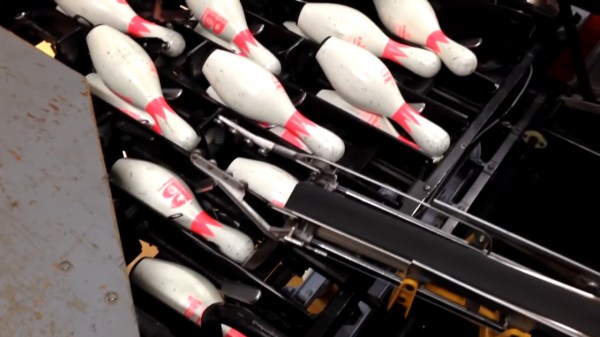On a recent bowling excursion it occurred to us that this is one of the most advanced robotics systems most Americans will directly interact with. That’s a bold claim today, but certainly one that was correct decades ago. Let’s take a stroll back to 1963 for a look at the state of the art in bowling at the time, the AMF automatic pinspotter.
With their basis in industrial automation, bowling was a perfect problem for the American Machine and Foundry company (AMF) to take on. Their business began at the turn of the 20th century with automated cigarette manufacturing before turning their sights on bowling pins after the second world war. The challenge involves more than you might think as pinspotters are confined to a narrow area and need to work with oddly-shaped pins, the bowling ball itself, and deal with setting up fresh frames but also clearing out the field after the first roll.
Separating the ball from the pins is handled by gravity and an oscillating plunger that pushes errant pins back onto a conveyor. That conveyor stretches the width of the lane and moves pins back to a pin elevator — a wheel moving perpendicular to the ground with orients and raises them to a swiveling conveyor belt that can drop them into the setting jig waiting for the next full frame setup.
Everything in this promo video has jargon which is just delightful. We especially enjoyed the non-mechanical mention of how the machine “clears dead wood from the pin deck”. We could watch this kind of automation all day, and in fact found some other gems while searching about. Here’s a more recent look a the AMF 82-70 (the same model as in the promo video). We also wondered about manual pinspotting and found this manual-with-mechanical-assist setup to be interesting despite the audio.
Much to our surprise we’ve featured AMF in a Retrotectacular article before. Once their bowling automation started to take off, they set their sights on restaurant automation. Looks like Brian Benchoff’s visit to the robo-hamburger joint was actually a retro experience!
Continue reading “Retrotechtacular: Robots And Bowling Pins”













